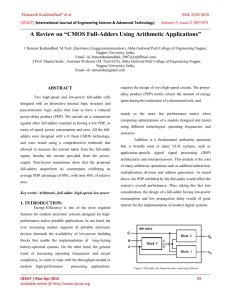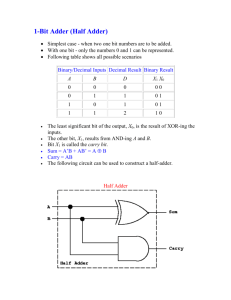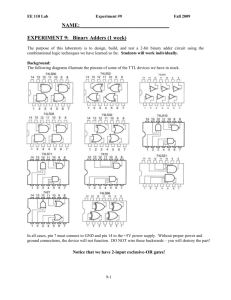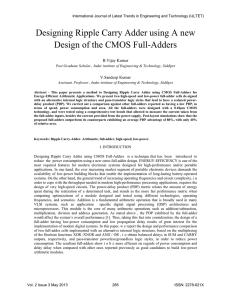Energy Efficient CMOS Full-Adders for Arithmetic Applications
advertisement
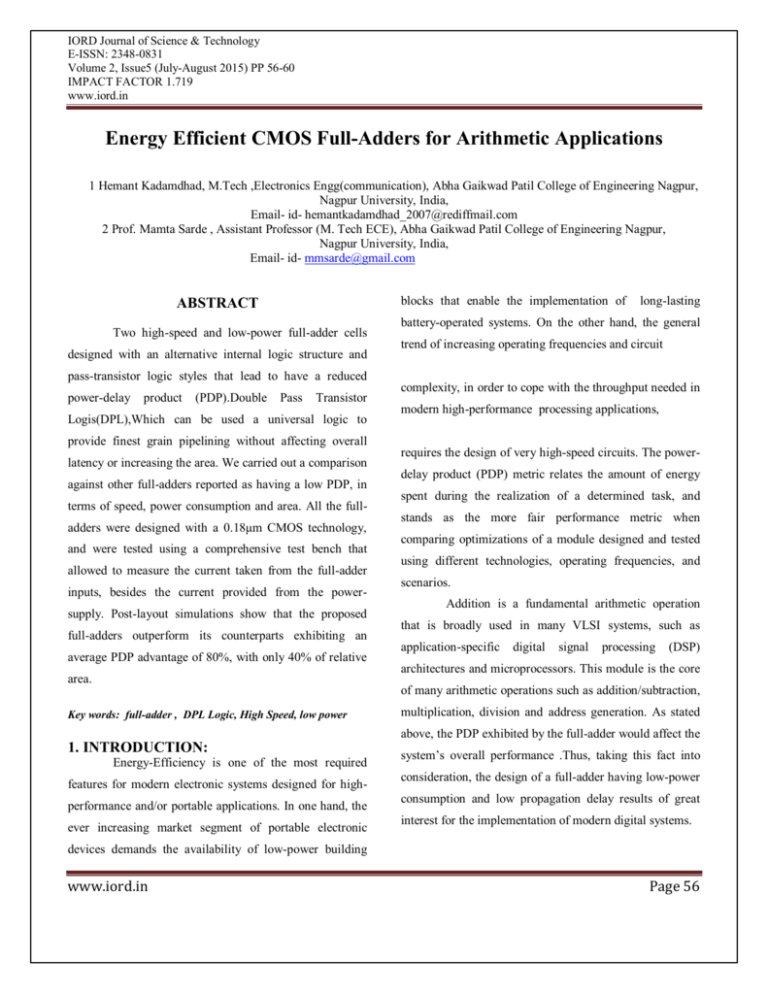
IORD Journal of Science & Technology E-ISSN: 2348-0831 Volume 2, Issue5 (July-August 2015) PP 56-60 IMPACT FACTOR 1.719 www.iord.in Energy Efficient CMOS Full-Adders for Arithmetic Applications 1 Hemant Kadamdhad, M.Tech ,Electronics Engg(communication), Abha Gaikwad Patil College of Engineering Nagpur, Nagpur University, India, Email- id- hemantkadamdhad_2007@rediffmail.com 2 Prof. Mamta Sarde , Assistant Professor (M. Tech ECE), Abha Gaikwad Patil College of Engineering Nagpur, Nagpur University, India, Email- id- mmsarde@gmail.com blocks that enable the implementation of ABSTRACT Two high-speed and low-power full-adder cells designed with an alternative internal logic structure and long-lasting battery-operated systems. On the other hand, the general trend of increasing operating frequencies and circuit pass-transistor logic styles that lead to have a reduced power-delay product (PDP).Double Pass Transistor Logis(DPL),Which can be used a universal logic to complexity, in order to cope with the throughput needed in modern high-performance processing applications, provide finest grain pipelining without affecting overall latency or increasing the area. We carried out a comparison against other full-adders reported as having a low PDP, in terms of speed, power consumption and area. All the fulladders were designed with a 0.18μm CMOS technology, and were tested using a comprehensive test bench that allowed to measure the current taken from the full-adder inputs, besides the current provided from the powersupply. Post-layout simulations show that the proposed full-adders outperform its counterparts exhibiting an average PDP advantage of 80%, with only 40% of relative requires the design of very high-speed circuits. The powerdelay product (PDP) metric relates the amount of energy spent during the realization of a determined task, and stands as the more fair performance metric when comparing optimizations of a module designed and tested using different technologies, operating frequencies, and scenarios. Addition is a fundamental arithmetic operation that is broadly used in many VLSI systems, such as application-specific digital signal processing (DSP) architectures and microprocessors. This module is the core area. of many arithmetic operations such as addition/subtraction, Key words: full-adder , DPL Logic, High Speed, low power multiplication, division and address generation. As stated above, the PDP exhibited by the full-adder would affect the 1. INTRODUCTION: Energy-Efficiency is one of the most required features for modern electronic systems designed for highperformance and/or portable applications. In one hand, the ever increasing market segment of portable electronic system’s overall performance .Thus, taking this fact into consideration, the design of a full-adder having low-power consumption and low propagation delay results of great interest for the implementation of modern digital systems. devices demands the availability of low-power building www.iord.in Page 56 IORD Journal of Science & Technology E-ISSN: 2348-0831 Volume 2, Issue5 (July-August 2015) PP 56-60 IMPACT FACTOR 1.719 www.iord.in with the addition of the inverters at the outputs. The size of the input buffers lets to experience some degradation in the input signals, and the size of the output buffers equals the load of four small inverters for this Figure 1 Full-adder cell formed by three main logical blocks. Full adder is combinational circuits that forms the arithmetic sum of three inputs bits. In full adder there is a Figure 3 Truth Table of a Full Adder three inputs and two ouputs. In our block diagram we use three inputs as A, B, Ci. The third input is carry input. The outputs are SUM and CARRY. There are not signals generated internally that control the selection of the output multiplexers. Instead, the C input signal, exhibiting a full voltage swing and no extra delay, is used to drive the multiplexers, reducing so the 2. REVIEW Many papers have been published regarding the optimization of low-power full-adders, trying different options for the logic style standard CMOS, differential cascode voltage switch (DCVS) , complementary passtransistor logic (CPL), double pass-transistor logic (DPL), swing restored CPL (SR-CPL), and hybrid styles, and the logic structure used to build the adder module . The internal logic structure shown in has been adopted as the standard configuration in most of the enhancements developed for the 1-bit full-adder module. In this configuration, the adder module is formed by three main logical blocks: a XOR-XNOR gate and XOR blocks or multiplexers to obtain the SUM and CARRY outputs (Blocks 2 and 3).[7]. The test bed used for the performance overall propagation delays. The capacitive load for the C input has been reduced, where the diffusion capacitance is becoming very large for sub-micrometer technologies. Thus, the overall delay for larger modules where the C signal falls on the critical path can be reduced. The propagation delay for the So and Co outputs can be tuned up individually by adjusting the XOR/XNOR and the AND/OR gates this feature is advantageous for applications where the skew between arriving signals is critical for a proper operation etc. Automatic emotion recognition from EEG signals is receiving more attention with the development of new forms of human-centric and human-driven interaction with digital media. 3. OBJECTIVE OF WORK analysis of the full-adders. This simulation environment has been used for comparing the full-adders analyzed in, www.iord.in Page 57 IORD Journal of Science & Technology E-ISSN: 2348-0831 Volume 2, Issue5 (July-August 2015) PP 56-60 IMPACT FACTOR 1.719 www.iord.in The main Aim is to implement CMOS Full-Adders Using Arithmetic Applications for Energy-Efficient. Comparison of two full-adder cells. The internal logic structure for designing a full-adder cell. The alternative internal logic structure to build the two proposed full-adders. Features of the simulation environment used for the comparison. Results obtained from the simulations. Schematic Design of Full Adder: 4. ALTERNATIVE LOGIC STRUCTURE FOR FULL ADDER: Examining the full-adder’s true-table in Table I, it can be seen the So output is equal to the B value when C=0 and it is equal to when C=1 Thus, a multiplexer can be used to obtain the respective value taking the C input as the selection signal. Following the same criteria, the Co output is equal to the A•B value when C=0 and it is equal A+B to C=1 value when C=1. Again, C can be used to select the respective value for the required condition, driving a multiplexer. 5. SIMULATION RESULT OF FULL ADDER: Design of Full Adder in Logical Structure: In simulation result, as follow three inputs with Sum and carry output at x-axis of voltage and y-axis of time period. Measurement result summary Avg power = 1.0441e-005 Schematic Design of Second stage of Full Adder Fig. Full-adder designed with the proposed logic structure and a DPL logic www.iord.in Page 58 IORD Journal of Science & Technology E-ISSN: 2348-0831 Volume 2, Issue5 (July-August 2015) PP 56-60 IMPACT FACTOR 1.719 www.iord.in SIMULATION RESULT OF FULL ADDER: Measurement result summary Avg power = 1.1887e-005 By adding the more number of Transistors in input circuitry we can reduce the average power of Full Adder. Power Comparison Table Measurement result summary Avg power = 2.6686e-005 Schematic Design of Third stage of Full Adder SIMULATION RESULT OF FULL ADDER: www.iord.in Sr No Time required Average Power First Stage Second stage Third Stage 2.24 second 1.25 second 1.51 second 1.0441e-005 2.6686e-005 1.1887e-005 6. CONCLUSION An another internal logic structure for designing full adder cells was introduced. In order to demonstrate its advantages, two full adders were built in combination with pass transistor logic style. For conceived many full adders we can use adder categorization and hybrid design style. In future by adding more number of transistors we can also reduce the average power of full adder circuitry. To determine the lowest power supply voltage of full adders can tolerate by its correct functionality. Delay in full adder relates the amount of energy spent during the realization of the determined task. The design of the full adder circuit Micro wind tool that allow measuring the Delay, Area, Power Consumption and Speed. REFERENCES: Page 59 IORD Journal of Science & Technology E-ISSN: 2348-0831 Volume 2, Issue5 (July-August 2015) PP 56-60 IMPACT FACTOR 1.719 www.iord.in [1] Mariano Aguirre-Hernandez and Monico Linares-Aranda “CMOS Energy-Efficient Arithmetic Applications” IEEE TRANSACTIONS 1063-8210 Full-Adders for ON VERY LARGE SCALE INTEGRATION (VLSI) SYSTEMS June.2010. [2] D. Patel, P. G. Parate, P. S. Patil, and S. Subbaraman, “ASIC implementation of 1-bit full adder,” in Proc. 1st Int. Conf. Emerging Trends Eng. Technol., Jul. 2008. [3] M. Aguirre and M. Linares, “An alternative logic approach to implement high-speed low-power full adder cells,” in Proc. SBCCI, Florianopolis, Brazil, Sep. 2005. [4] A. M. Shams, T. K. Darwish, and M. Bayoumi, “Performance analysisof low-power1-bit CMOS full adder cells,” IEEE Trans. Very Large Scale Integr. (VLSI) Syst., vol. 10, no. 1, Feb. 2002. [5] D. Radhakrishnan, “Low-voltage low-power CMOS full adder,” IEEE Proc. Circuits Devices Syst., vol. 148, no. 1, pp. 19–24, Feb. 2001. [6] R. Zimmerman and W. Fichtner, “Low-power logic styles: CMOS versus pass-transistor logic,” IEEE J. Solid-State Circuits, vol. 32, no. 7, pp. 1079–1090, Jul. 1997. [7] N. Zhuang and H. Wu, “A new design of the CMOS full adder,” IEEE J. Solid-State Circuits, vol. 27, no. 5, pp. 840–844, May 1992. [8] N.Weste and K. Eshraghian Principles of CMOS VLSI Design , A system perspective. Reading, MA: Addison-Wesley, 1988, ch. 5. [9] C. Chang, and M Zang , “ A Review of 0.18-μm full adder performance for tree structured arithmetic circuits ,” IEEE Transaction. VLSI system, vol. 13, no.6, pp.686-695, Jun 2005. www.iord.in Page 60

